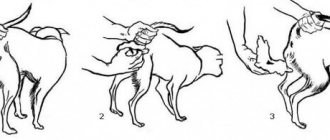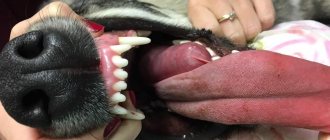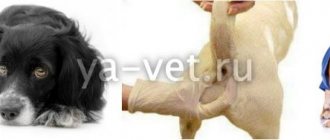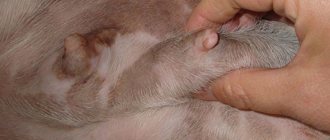Our pets often suffer from “human” diseases, and hypothyroidism in dogs is one of these pathologies - a disease that occurs as a result of a decrease in the level of hormones produced by the thyroid gland.
Scientists attach great importance to hormones, which are involved in almost all metabolic processes occurring in the body and affect the functioning of all organs. Based on this, we can conclude that proper hormonal levels are one of the factors for a dog’s good health.
Let's figure out why dogs suffer from hypothyroidism, consider methods of diagnosing and treating it.
How does hypothyroidism occur?
The main cause of the disease is a “breakdown” in the thyroid gland, which is located in the larynx of dogs and has the shape of a butterfly, consisting of two lobes. The pituitary gland controls the activity of the thyroid gland with the help of special hormones. They “force” the thyroid gland, in turn, to produce its own hormones triiodothyronine (T3) and thyroxine (T4), which regulate the functioning of all organs.
It would seem that malfunctions of the thyroid gland should manifest themselves in cases of problems with the pituitary gland, since without its “guidance” it will not be able to work. But veterinary practice shows that thyroid diseases occur in dogs with an absolutely healthy pituitary gland. Why then do they suffer from hypothyroidism?
What is hypothyroidism in dogs
Hypothyroidism is a disease that is accompanied by insufficient production of thyroid hormones. The human or animal body always suffers greatly from such a malfunction, and therefore it is advisable to notice the disease as early as possible.
The thyroid gland is located at the top of the trachea, behind the larynx. The product of its work is thyroid hormones, which are involved in protein synthesis, regulation of metabolism, functioning of the nervous system and many other processes. If a dog regularly experiences a decrease in hormones, then very soon this will make itself felt with external symptoms.
True, hypothyroidism in dogs may not be recorded as often as it actually is. This is due to the fact that the disease can proceed secretly for a long time, masquerading as other ailments. Therefore, it is necessary to direct all efforts to identify the pathology earlier and begin etiotropic treatment.
Types and causes of the disease
There are several types of this disease in dogs:
- Primary hypothyroidism, in which the thyroid gland stops producing hormones in sufficient quantities.
- Secondary hypothyroidism occurs due to decreased stimulation of the thyroid gland by the pituitary gland.
- Tertiary hypothyroidism, manifested as a result of a lack of neurohormones of the hypothalamus.
In dogs, primary hypothyroidism is diagnosed in more than 90% of cases. Of these, almost half are an autoimmune disease - chronic thyroiditis. At the same time, the dog’s own immunity attacks the thyroid gland and causes it to produce more and more hormones.
Such increased activity of the gland quickly depletes it and a lack of thyroid hormones occurs, that is, hypothyroidism. The remaining 50% of cases of primary hypothyroidism belong to such variants of the development of the disease when atrophy of the thyroid gland occurs for unknown reasons.
Hypothyroidism can be congenital and inherited in dogs, but the percentage of this type of disease is very small.
Another cause of this pathology may be infectious diseases and the presence of endoparasites. Currently, veterinarians have information that when a dog is infected with worms for a long time, the toxins produced by the parasites can affect many organs, including the thyroid gland.
If a dog undergoes long-term and uncontrolled treatment with hormonal drugs, this can also cause a malfunction of the thyroid gland.
Description
As mentioned above, hypothyroidism in dogs is associated with dysfunction of the thyroid gland. As a result of this disorder, iron begins to produce fewer hormones: this affects the metabolic processes in the animal’s body. Essentially, hypothyroidism is the insufficient production of certain hormones by the thyroid gland. Most often the disease is acquired, much less often it is congenital.
Today, veterinarians are faced with two types of canine hypothyroidism - primary and secondary:.
- Primary hypothyroidism also has a second name - “Hashimoto’s disease”, and is caused by external factors: iodine deficiency, infections, thyroid tumors, etc. Primary hypothyroidism is treated quite well if you go to the clinic in a timely manner. This type of hypothyroidism occurs in 95% of all cases of the disease.
- Secondary hypothyroidism is more dangerous and leads to serious consequences than primary hypothyroidism. In this case, the disease develops at a young age and negatively affects the growth and development of the dog. Sometimes secondary hypothyroidism also leads to dwarfism in dogs, even initially large breeds. Typically, secondary hypothyroidism develops due to problems and pathologies of a congenital nature, as well as due to a tendency to form tumors. In some cases, secondary hypothyroidism can result from poor dog diet or steroid treatment.
The disease has a fairly extensive list of symptoms - we will talk about them a little further. Obese dogs are especially susceptible to the disease. Therefore, excess weight of the animal is a provoking factor in this case. In addition, a dog's baldness and skin problems can also indicate the likelihood of hypothyroidism.
The disease is diagnosed simply - just visit a veterinary clinic: for an accurate diagnosis you need to take a blood test. During the study, a specialist will check the level of hormones in the dog’s blood and compare this indicator with the “norm”.
Let us note that today hypothyroidism in dogs is incurable in the vast majority of cases, but with regular administration of special medications, dogs live well with the disease for many years, feeling quite well.
How does the disease manifest itself?
Considering the fact that the lack of thyroid hormones has a significant impact on the functioning of all organs of the dog, the signs of hypothyroidism will be varied. Moreover, it is necessary to take into account that the symptoms of hypothyroidism are often mistaken for other diseases.
However, there are classic manifestations of the disease that indicate problems with the thyroid gland:
- increase in dog weight by 15-20%;
- lethargy and apathy in the animal;
- the appearance of dandruff and bald areas;
- Digestive problems.
Signs of hypothyroidism increase rather slowly over a long time and at first do not alarm the dog owner at all; he may mistake them for age-related changes or another disease. What symptoms should the owner pay closer attention to in order to begin treatment for the pet on time?
First of all, you should focus on the mood and behavior of your pet. If you notice that your dog has become sad and lethargic, is reluctant to go for walks, plays less and sleeps more, then this is a reason to watch him more closely.
With hypothyroidism, impaired metabolism leads to a change in the animal's thermoregulation function, so the dog begins to quickly freeze outside, and settles down at home in the warmest place.
With the same diet, has your pet suddenly gained weight or has swelling on its face? This may also indicate a thyroid disease.
A characteristic symptom of hypothyroidism is hair problems. The dog may develop dandruff and bald patches.
If you notice similar symptoms in your dog, contact a competent veterinarian so that the diagnosis is made correctly and the treatment initiated is adequate.
Signs and symptoms
With a small level of deviation in the synthesis of thyroid hormones, the manifestations are weakly expressed, it is difficult to understand why the condition of the coat and skin worsens or weakness develops. The greater the deficiency of triiodothyronine and thyroxine, the more signs of hypothyroidism appear.
A visit to the veterinarian is required if negative symptoms appear:
- lethargy, general weakness, apathy (behavior changes develop in 70% of pets with hypothyroidism);
- the dog is in no hurry to go for a walk, in his free time he tries to lie down instead of active games;
- hair thins and falls out;
- the coat becomes dull, dry, brittle;
- dandruff appears;
- infectious lesions of the skin develop;
- for no apparent reason, while maintaining the usual diet, weight increases;
- sometimes convulsions, involuntary tilting of the head develop, swelling of the limbs is possible;
- the animal is very cold under the same conditions as before;
- the bitch does not become pregnant, the dog does not come into estrus or does not go into estrus regularly at the onset of puberty, tests show hormonal infertility.
Nonspecific signs
In addition to the symptoms that are considered “mandatory” for hypothyroidism, there are a number of nonspecific signs:
- Ophthalmology. With hypothyroidism, the amount of lipolysis products in the blood increases, which are subsequently deposited in places of small lesions of the cornea and lead to its degeneration. Less commonly, corneal ulceration or inflammation of the vascular network of the eye may occur.
- The cardiovascular system. A decrease in the level of thyroid hormones can lead to bradycardia, arrhythmia and other cardiac disorders.
- Neurology. Hypothyroidism produces various manifestations that affect the functioning of the central and peripheral nervous system. In 70% of sick dogs, this is expressed in apathetic or unusual behavior, and problems with the vestibular apparatus may also arise. Often with hypothyroidism, paresis or paralysis of the facial/trigeminal nerve can occur.
- Dermatology. Dermatological manifestations of hypothyroidism most clearly indicate to the dog owner that there is a problem. The pet begins to develop patches of baldness, first affecting the back of the nose and the surface of the tail, and then they spread to the groin, armpits, and abdomen. In this case, the animal does not itch, that is, the hair falls out on its own. In bald areas, the pigmentation of the skin changes and it becomes drier, since with hypothyroidism the sebaceous glands atrophy and secretion production decreases.
- Reproductive system. Bitches with hypothyroidism lose the ability to fertilize or cannot bear full-fledged offspring due to miscarriages. In addition, the period between estrus increases up to 10 months or they stop altogether, and in males the sexual desire decreases.
Symptoms
Since a decrease in the production of hormones in the thyroid gland directly affects the metabolic processes in the dog’s body, the symptoms of hypothyroidism are very diverse, affecting almost all aspects of the animal’s life. Without exception, all body systems, internal and external organs suffer. For this reason, the symptoms of hypothyroidism are very vague and do not differ in certainty. The diagnosis is made only after a thorough blood test, since it is not possible to accurately determine hypothyroidism based on external symptoms. However, there are some symptoms that in 60-70% of cases indicate hypothyroidism. Let's look further at hypothyroidism in dogs, their symptoms and treatment of this disease.
- The dog falls into apathy, becomes lethargic, and lacks initiative. If your pet used to run around like crazy and play, now he lies down more and more and shows no interest in activity. The dog gets tired quickly and can hardly stand long walks. A dog with hypothyroidism becomes intolerant to exercise. And if earlier she cheerfully rushed for a stick in the park, now she just sits apathetically on the sidelines.
- The animal's hair begins to fall out. At the same time, the wool becomes dry, brittle, and loses its shine. The dog's nose often thins out, as well as the groin area, areas in the armpits, and the neck under the collar. If hypothyroidism is complicated by infections, then the dog may experience itching in addition to skin problems. The expression of the muzzle takes on a “sad” expression, as with spondylosis. It is the last symptom that dog owners pay attention to first.
- A sad face is obtained due to the drooping of the eyelids and corners of the mouth. In addition, the front of the animal’s head also swells greatly. Often, as a result of this disease, the function of the secretory glands, as well as the lacrimal glands, is impaired. Therefore, the dog's eyes become constantly wet and drool flows from his mouth.
- Skin pigmentation becomes noticeable. Dandruff forms on the skin under the fur, some areas may turn pink, become covered with scabs, and go bald. If the process is neglected, then an unpleasant odor may emanate from the dog’s skin due to the rapid proliferation of bacteria. The animal may also develop skin diseases such as seborrhea and dermatitis.
- Hypothyroidism leads to the fact that the animal begins to look extremely untidy. The dog's fur hangs in clumps, is difficult to comb, has bald spots, becomes greasy, oily while the skin is dry at the same time. The tail takes on a “rat” shape and thins out.
- The animal develops a negative reaction to cold and intolerance to low temperatures. The animal constantly strives to hide in a warmer place - under a radiator, on a rug, closer to heating devices.
- There may also be a slowdown in heart rate. The functioning of the dog's cardiovascular system is disrupted. The animal has a decrease in hemoglobin, and bleeding may occur.
- The animal's behavior also changes. The dog becomes timid, shys away from passers-by on the street, and reacts inadequately to loud sounds, even from the TV. Some animals, on the contrary, may exhibit unusual aggressiveness - this is a kind of defensive reaction. Mood swings from extreme timidity to excessive aggression are also possible.
- Hypothyroidism in dogs also has ophthalmological symptoms. Under the influence of the disease, the animal may develop dry eyes, various infections of the organs of vision, and conjunctivitis may occur. The animal’s gaze becomes “floating” and loses its former sharpness.
- If hypothyroidism develops in a female, she has problems with pregnancy, gestation, childbirth, and feeding. Often, with developed hypothyroidism, a dog gives birth to premature or dead puppies. In male dogs, as a result of the disease, libido is greatly reduced.
- The digestive system also malfunctions. The dog may suffer from diarrhea, constipation, and indigestion. Sometimes the animal may vomit after eating.
- Note that congenital hypothyroidism entails swelling of the dog’s skin and also leads to the appearance of a goiter. The cause of congenital hypothyroidism is iodine deficiency in the mother, as well as defects in the intrauterine development of the puppy. Very often such individuals are born dead or poorly adapted to life.
- Signs of the disease also include staggering gait, paralysis, muscle atrophy, sagging of the upper eyelid, decreased growth, hormonal pathologies, deterioration of the sense of smell, and renal failure. Often the dog gains significant weight, to the point of becoming obese.
Let's celebrate! that not all symptoms appear in the early stages - many of them are noticeable only when hypothyroidism has already developed quite strongly. But the development of the disease occurs rather slowly, so attentive dog owners have every chance to treat their pet in the early stages, avoiding dangerous consequences of the disease.
Diagnostic methods
To accurately diagnose hypothyroidism, it is necessary to consider test results in conjunction with the classic symptoms of this disease. At the moment, the equipment of many veterinary clinics does not allow a complete analysis of thyroid hormones. The main method is to determine the concentration of total T4 in the blood plasma, and in some cases an analysis for TSH or thyroid-stimulating hormone is added.
But a dog’s total TSH and T4 levels are influenced by many factors, and their deviation from the norm cannot 100% indicate the incidence of hypothyroidism. For example, some medications and anesthesia used less than 48 hours before the test have an effect.
Infectious diseases, oncological tumors, chronic liver or kidney diseases can greatly change the level of total T4.
For a more accurate diagnosis, it is necessary to know the level of free T4, which is determined in the dog’s blood only by the method of equilibrium dialysis. Other methods do not make it possible to evaluate this indicator correctly.
To complete the picture, it is better to conduct additional research:
- general and biochemical blood test;
- Analysis of urine;
- ECG;
- Ultrasound of the heart.
It is very difficult to assess the function of the thyroid gland only on the basis of laboratory tests, so the veterinarian is faced with the task of correctly “reading” the test results and comparing them with the symptoms of the disease that appear in the dog.
Carrying out ultrasound and analysis of thyroid cells is justified only if the animal is suspected of having a tumor of this organ; in case of hypothyroidism, these methods are not sufficiently informative.
Treatment
Treatment for hypothyroidism is relatively simple, and the prognosis for this disease is quite favorable. Replacement treatment with thyroid hormone medications leads to improvement or complete elimination of the symptoms of the disease.
Currently, the most commonly used drug is levothyroxine and is recommended for the treatment of all types of hypothyroidism.
An important rule for treating canine hypothyroidism is that the dose of levothyroxine differs significantly from the dose used to treat human hypothyroidism. And the first obstacle to successful treatment is, oddly enough, the salesperson at the pharmacy. When selling L-thyroxine to people, this person will try to convince you that the doctor made a mistake in the dose and in fact you need a dose five times less than what the doctor prescribed. Unfortunately, this is what many owners of dogs with hypothyroidism face.
Thyroid hormone replacement therapy is carried out only with a confirmed diagnosis. Unfortunately, this rule is not always followed. Of course, the use of L-thyroxine will in any case improve the condition of the skin, coat, and perhaps even eliminate other symptoms that bother the owner, but these changes will be temporary. These visible improvements are possible even if the diagnosis is incorrect and hypothyroidism is not present.
With a correct diagnosis, a successful treatment outcome is likely and the prognosis of the disease will be good, but the animal will need thyroid hormones for the rest of its life. The dosage of drugs varies and should be selected strictly individually; during treatment, the concentration of thyroid hormones in the patient’s blood should be regularly examined. The initial dose (the one with which treatment of hypothyroidism begins) is 10-20 mcg/kg of dog weight 2 times a day (approximately once every 12 hours). The half-life of T4 in dogs is 9-15 hours and, accordingly, a double dose of the drug most consistently normalizes the concentration of T4 in the blood serum. If it is necessary to simultaneously administer drugs that suppress the binding ability of blood plasma proteins (glucocorticoids, salicylates), higher doses of L-thyroxine may be required.
The pharmacokinetics of levothyroxine varies greatly among dogs when administered orally. Dogs with concomitant diseases - diabetes mellitus, hypoadrenocorticism, congestive heart failure - should initially receive ¼ of the indicated dose of levothyroxine. Then it is permissible to increase the dose by ¼ every 2 weeks until the appropriate concentration of total T4 in the blood serum is achieved.
Puppies with congenital hypothyroidism require much larger initial and ongoing doses of levothyroxine.
Thus, in any case, the dose of levothyroxine is always selected individually and adjusted depending on the concentration of thyroid hormones in the blood serum.
During treatment, the symptoms of hypothyroidism gradually begin to regress. In most dogs, clinical signs of the disease begin to disappear as the total T4 concentration in the blood serum approaches the upper limit of normal. First of all, drowsiness and apathy usually disappear in the next few days after starting the use of levothyroxine. Restoring the coat is the longest process, which can take several months. On average, the full recovery of the patient’s condition can be judged only 3 months after the start of replacement therapy.
Symptoms of a possible overdose of levothyroxine are signs of hyperthyroidism (as opposed to excessive thyroid function, thyrotoxicosis): restless and even aggressive behavior of the dog, frequent and intermittent breathing, possible appearance of excessive thirst, increased appetite, diarrhea. In these cases, the dose of the drug received must be adjusted. Thyrotoxicosis can be confirmed by detecting elevated serum T4 levels. Side effects of levothyroxine that are not associated with overdose are extremely rare.
With concomitant severe hypochromic anemia with a violation of the general condition, vitamin B12, iron-containing drugs and hematopoiesis stimulants should be added to the treatment.
Patient follow-up and prognosis
Plasma T4 concentrations are assessed several weeks after the start of therapeutic treatment. The peak concentration of total T4 in the blood serum occurs 4-8 hours after oral administration of levothyroxine. The concentration of total thyroxine in the blood at this time should reach normal values or numbers slightly exceeding the reference limits. Immediately before taking the drug, the total T4 content in the blood serum should be at the lower limit of normal.
A low T4 concentration both before and after taking levothyroxine indicates an inappropriate low dose. This is possible if the absorption of the drug in the intestine is impaired, the frequency of administration is incorrect, or the tablets are administered incorrectly. Also, the need to adjust the dose of the drug will be indicated by unremovable symptoms of insufficient thyroid function, or, conversely, symptoms of overdose. If symptoms of hyperthyroidism are present, the dose of the drug should either be significantly reduced (to the minimum initial dose) or, in some cases, levothyroxine should be discontinued until the symptoms of overdose disappear.
Lifelong hormone replacement therapy and monitoring of total T4 levels in the blood serum prevent the development of clinical manifestations of relapse of the disease. The prognosis for adult dogs with primary hypothyroidism that receive appropriate replacement therapy at an adequate dose is quite good.
Given the frequency of errors in diagnosing hypothyroidism, it is important to assess the condition of the patient receiving the drug in the absence of the disease. What will happen to a dog if it is treated with levothyroxine for pseudohypothyroidism? Administration of levothyroxine to healthy euthyroid dogs, of course, due to a negative feedback mechanism, leads to a decrease in the production of thyroid-stimulating hormone by the pituitary gland. If supplemental thyroid hormone is discontinued after long-term use, it may take several weeks or months for the relationship between pituitary and thyroid hormones to be restored. In the vast majority of cases, this recovery occurs without any consequences for the dog's health.
So, assessing the functional activity of the thyroid gland is far from a screening or routine study! It should be carried out only if there are clinical data indicating the possibility of the disease. Interpretation of laboratory data is an important and careful task that should only be performed by a physician.
Diagnostics
The first stage is inspection of the animal and conversation with the owner. The veterinarian establishes the clinical picture and clarifies how long ago the owner noticed signs of hormonal imbalance. When there is a significant deviation in the synthesis of T4 and T3, the animal exhibits several signs of regulatory deficiency.
Laboratory tests are required: determination of the level of triiodothyronine, thyroxine, TSH, general blood and urine analysis. Indicators of free T4 provide a lot of information about the state of the thyroid gland: thyroxine is produced only by an important gland, and a low level of the hormone immediately indicates problems with the endocrine system.
A highly informative study is a specific “load” test: the dog is given a certain dose of thyroxine. If after a period of time during control measurements the indicators barely reach the optimal level, then a deficiency of the hormone is confirmed in the body. In healthy dogs, a test with a dose of T4 shows a significant excess of the norm, because the body produces the regulator in sufficient quantities.
If a tumor process is suspected, an x-ray of the thyroid gland must be prescribed. An ultrasound examination of the thyroid gland shows the general condition and size of the endocrine gland.
Myxedema coma
Myxedema coma is apparently the most severe complication of hypothyroidism. Although recognition is rare, it is more common than it seems. In many cases, it cannot be recognized due to unusual symptoms and the high mortality rate associated with the disease. Myxedema coma occurs as a result of decompensation of chronic hypothyroidism, often caused by a concomitant disease or drug intake. The metabolic consequences of hypothyroidism cause numerous compensatory physiological responses. Peripheral vasoconstriction occurs to maintain core body temperature, which typically decreases in response to decreased metabolic rate, cardiac output, and vascular volume. A decrease in beta-adrenergic reactivity without a similar change in alpha-adrenergic response contributes to a decrease in vascular volume and diastolic hypertension as a result of constriction of blood vessels. In hypothyroidism, a decrease in renal blood flow (caused by cardiovascular pathological changes) and an increase in the release of arginine vasopressin disrupt the process of clearing osmotically free water. A decrease in the respiratory response to hypercapnia (increased carbon dioxide in the blood) along with weakness of the respiratory muscles leads to hypoventilation and hypercapnia. In addition, people with hypothyroidism have decreased metabolism of many medications, leading to increased side effects.
It is these compensatory reactions to hypothyroidism that indicate the severe nature of myxedema coma. Decompensated hypothyroidism and myxedema coma are the result of a change in mental status, thermoregulation disorder, precipitant event, or disease. Similar events in humans include congestive heart failure and other acute illnesses, infections, surgery, trauma, hypothermia, and use of diuretics or central nervous system or respiratory system depressants. Clinical signs in dogs include a dull or comatose mental state, hypothermia without shivering, bradycardia, hypotension, and decreased ventilation along with typical signs of hypothyroidism and cutaneous myxedema. Clinicopathologic abnormalities include mild nonregenerative anemia, hypercholesterolemia, and hyponatremia. X-ray examination shows pleural effusion and increased pulmonary pattern. Treatment should be started immediately, often before results of thyroid function testing are available. Thus, clinical signs of hypothyroidism in combination with previous disorders should lead the clinician to consider myxedema coma as a diagnosis.
When treating myxedema coma, it is necessary to restore impaired compensatory reactions and the function of the thyroid hormone. To eliminate hypothermia, so as not to cause peripheral dilatation of blood vessels and exacerbation of arterial hypotension, passive warming of the dog is recommended, for which it is covered with blankets, instead of active warming with a heater. Because the compensatory mechanisms of long-term hypothyroidism lead to a decrease in blood volume, any degree of hypotension is considered serious and should be treated promptly. Direct or indirect measurement of blood pressure is preferable to assessments such as pulse quality and time to disappearance of the white spot (when pressure is applied to the skin). Crystalloid fluid supplementation should be prescribed, but care should be taken not to induce hyponatremia as the patient has decreased clearance of osmotically free water. In some cases, it will be useful to prescribe colloids such as hetastarch or dextran. Dogs with underlying congestive heart failure are at increased risk due to worsening fluid retention and pulmonary edema during intravenous infusions. If other treatments do not relieve hypotension, dopamine infusions are given. Dopamine is preferred over other drugs because it preserves coronary and renal blood flow.
Infection is the most common precipitating event for myxedema coma in humans. All dogs with decompensated hypothyroidism should be fully evaluated for infection or other serious illness. Broad-spectrum antibiotics should be given as part of the initial treatment until the presence or absence of infection is confirmed. Glucocorticoid medications such as hydrocortisone, prednisolone, or dexamethasone sodium phosphate are recommended due to the reduction in cortisol release as a result of the stress response in severe hypothyroidism. Hypoventilation of the lungs can be judged by hypercapnia observed when monitoring arterial blood gases. In severe cases, it should be eliminated by mechanical ventilation.
Thyroid hormone replacement should be done intravenously to avoid delays in absorption through the gastrointestinal tract. Although the dose and specific type of this hormone are controversial, the author recommends a loading dose of intravenous levothyroxine (Synthroid Injection, Knoll Pharmaceutical, Mount Olive, New Jersey) that is 3 to 5 times the usual daily dose (0.066 to 0.11 mg/kg). If thyroxine injection is not available, it should be given orally at the usual replacement dose of 0.022 mg/kg every 12 hours. The prognosis in this case ranges from cautious to unfavorable, but identification and treatment of any concomitant disease in combination with the necessary treatment of myxedemia can eliminate this severe complication of hypothyroidism.
How to treat
After making a diagnosis, the veterinarian prescribes treatment, which will consist of taking hormone replacement medications. The hormone levothyroxine is usually used. With the correct dose and proper use of medications, the symptoms of the disease disappear quite quickly.
But canine hypothyroidism also has its pitfalls. So, if a veterinarian misdiagnoses the disease and prescribes levothyroxine to a dog that does not have hypothyroidism, then after a while the dog may lose some of the symptoms of the disease, but this improvement will be temporary. With such improper treatment, valuable time may be lost to treat another disease.
The initial dose of levothyroxine is 10-12 mcg/kg of dog weight twice daily. During treatment, blood tests are periodically done to monitor the progress of treatment, and, if necessary, adjust the dose of the medication and bring the T4 level to normal.
A dog with hypothyroidism will continue to be on medication for the rest of their lives, but their survival prognosis is very good. After the start of treatment, the main symptoms of the disease soon disappear - the dog becomes cheerful, active, and the bald spots begin to heal. It may take 3-4 months for the coat to fully recover.
When an overdose of medication occurs, the dog develops symptoms opposite to those it had during the illness. She may become nervous, aggressive, lose weight, and experience extreme thirst. In this case, you need to visit a doctor to adjust the dose of the medication you are taking.
Is it possible to prevent hypothyroidism???
There is no way to prevent this disease, but proper diagnosis and proper treatment allow dogs and their people to live normal lives...
This article is purely informational. HowMeow.ru does not have the right to prescribe veterinary treatment or diagnose. We invite you to take your pet to the vet if you are suffering from any illness or pain.
Hypothyroidism
Hypothyroidism
is an acquired or congenital metabolic disease that develops as a result of insufficient quantities or impaired utilization of thyroid hormones.
Since thyroid hormones influence the growth and development of the body and regulate many intracellular processes, hypothyroidism leads to numerous systemic disorders. Etiology.
Congenital hypothyroidism, caused by iodine deficiency or enzymatic defects, is very rare and is accompanied by swelling of the skin and the presence of a goiter.
Such puppies are born dead or non-viable. In growing dogs, hypothyroidism occurs as congenital or acquired cretinism and is rare. Clinically, goiter, disproportionate dwarfism, idiocy, and sometimes symmetrical alopecia are observed. We have not encountered any cases of hypothyroidism in young dogs; perhaps the owners simply do not pay attention to such nonspecific symptoms as stupidity, calm character and dwarfism, moreover, in some breeds they are even desirable. Most cases of hypothyroidism occur in middle-aged and older dogs. Depending on the reasons for the decrease in the functional activity of the thyroid gland, a distinction is made between primary hypothyroidism, caused by insufficient production of thyroid hormones itself, secondary hypothyroidism, associated with insufficient stimulation of the gland by the adenohypophysis, and tertiary hypothyroidism, caused by a lack of thyrotropin-releasing factor of the hypothalamus. The main causes of primary hypothyroidism are: hereditary defects in the biosynthesis of thyroid hormones, hypoplasia and aplasia of the thyroid gland (idiopathic, thyroiditis, neoplasia), insufficient intake of iodine into the body. According to the literature, 90% of cases of primary hypothyroidism are a consequence of chronic autoimmune thyroiditis. Secondary hypothyroidism occurs indirectly as a result of thyroid-stimulating hormone (TSH) deficiency and accounts for only 5% of cases. The causes of secondary hypothyroidism can be abnormalities in the development of the pituitary gland, usually due to birth trauma, tumor damage or nutritional depletion, as well as Cushing's syndrome. Secondary hypothyroidism can also be provoked by non-thyroid diseases with impaired transport and peripheral metabolism of thyroid hormones (severe injuries, intoxication) - “Sick Euthyreoid Syndrom” - transient secondary hypothyroidism. This is believed to be an adaptive response to increased catabolism. During the research, the dependence of the functioning of the thyroid gland on the neutralizing ability of the kidneys was also revealed: in all cases of chronic renal failure, a decrease in the production of thyroxine was found. When stabilization is achieved, the level of thyroid hormones returns to normal, so this condition can be regarded as temporary and does not require replacement therapy. Secondary hypothyroidism can also be caused by taking goitrogenic drugs (struma - goiter in hypothyroidism). Among the drugs used in everyday practice and affecting the level of thyroid hormones, we can note metoclopramide (reduces TSH levels), sulfonamides (reduces T4, T3, TSH levels), salicylates (reduces T4). One of the etiological factors of secondary hypothyroidism may be iatrogenic hypercortisolism caused by long-term use of glucocorticoids. The mechanism of this disorder is the suppression of thyroid function due to inhibition of TSH secretion by the adenopituitary gland. Tertiary hypothyroidism is caused by congenital malformations, hypothalamic tumors, and encephalitis. Peripheral hypothyroidism is recorded in cases of congenital resistance of target tissues to thyroid hormones or inactivation of circulating T3, T4, TSH. In practice, we usually deal with primary hypothyroidism. Clinical signs
.
Hypothyroidism has a wide variety of clinical presentations. Symptoms of the disease appear gradually. The initial manifestations of hypothyroidism are characterized by scanty and nonspecific symptoms: weakness, lethargy, fatigue, decreased body temperature. A decrease in basal metabolism, impaired thermoregulation with a predominance of heat transfer over heat production reduces tolerance to cold. Animals are looking for a warm place, crawling under the owner’s blanket. On the skin side, thyroid insufficiency in most cases (62%) is accompanied by total diffuse alopecia (baldness) or thinning of the coat on the back and sides of the animal with no traces of scratching. The animal looks very untidy: disheveled, thin and dull fur, puffy muzzle. Quite often (21%) alopecia of the dorsum of the nose and the dorsal surface of the tail is observed - “rat tail”. A more rare variant of the development of the disease is slow regrowth of hair after cutting (5%) in the absence of alopecia or focal alopecia in the lumbar and croup area (14%). Slowing of peripheral blood flow, accompanying anemia and specific edema (“mucinosis”) make the skin feel cold, thickened and tight, like a pig’s. An excess of glucoaminglycans in hypothyroidism changes the colloidal structure of the connective tissue, increases its hydrophilicity, which, under conditions of slow lymph flow, forms myxedema. As a result, the puffy shape takes on an expression of sadness, which is what the owners notice first. Light-colored dogs may have noticeable acne - “comedones”, especially in the back and abdomen. Hyperpigmentation of bald areas is also characteristic, since under conditions of hypothermia the activity of other endocrine glands, primarily the adrenal cortex, is limited and, as a result, the synthesis of ACTH and the associated MSH is increased. You can often notice yellowness of the skin, which is explained by the slow transformation of β-carotene into vitamin A. Itching with hypothyroidism appears only when sulfur otitis and pododermatitis are complicated by malassezia (a disease caused by the proliferation of a yeast-like fungus) or bacterial infections (Staph. Intermedius, E. coli) . Additional symptoms include otitis media, which is recorded in 56% of cases, and pododermatitis (23%). 82% of animals with hypothyroidism are overweight. Sometimes owners notice a dog’s hoarse voice, which is usually associated with a cold (6%). It should be noted that bradycardia, described in most sources as a constant companion of hypothyroidism, is observed relatively rarely - in 15% of cases. In females there are long intervals between heats - up to 8-10 months, in males there is a lack of interest in the opposite sex. It should be noted that a decrease in thyroxine in the blood through a feedback mechanism increases the secretion of TSH and often prolactin. Therefore, hypothyroidism very often aggravates the symptoms of false pregnancy. The most common signs of hypothyroidism are found in dogs of the small poodle (29.2%), French bulldog (16.7%) and English bulldog (12.5%) breeds. In poodles, hypothyroidism occurs in the most classic form with large-focal or total alopecia spreading from the lower back throughout the body, alopecia of the dorsum of the nose and dorsal surface of the tail, reduced tolerance to cold and doughy, swollen skin. Quite often the process is accompanied by complicated sulfur otitis and pododermatitis and a tendency to obesity. In bulldogs, clinical manifestations of hypothyroidism are usually limited to otitis media, keratoconjunctivitis sicca and alopecia of the nasal dorsum, but they have the lowest T4 values - 8.0-9.0 nmol/l. A study of the “hormonal mirror” of the blood allows us to identify the primary or secondary nature of the lesion: a decrease in the level of T4 and an increase in TSH indicate the primary origin of the pathology: a decrease in the level of both hormones speaks in favor of the secondary or tertiary nature of the disease. Sometimes it is possible to diagnose a latent form of primary hypothyroidism, in which the clinical signs of hypothyroidism are mild, the T4 level is normal, but TSH is elevated. It is quite difficult to diagnose cases of peripheral hypothyroidism associated with generalized or partial resistance of target tissues to the influence of thyroid hormones, caused by genetic factors. Such diseases are not described in the literature on veterinary medicine. In dogs with hypothyroidism, the number of red blood cells significantly decreases by 8.8%, the cholesterol level increases by 2.43 times, the content of creatine kinase increases by 13.7 times, alkaline phosphatase by 8.7 times, and triglycerides by 5.7 times relative to the norm. The development of anemia in hypothyroidism is caused by suppression of erythropoiesis (production of red blood cells by the red bone marrow) due to a decrease in basal metabolism, impaired absorption of iron and vitamin B12 in the gastrointestinal tract, which determines the need for the use of cyanocobalamin (vitamin B12) and iron-containing drugs in the treatment of hypothyroidism. An increase in the content of lipolysis products (cholesterol, triglycerides) in the blood is due to a slowdown in the utilization and excretion of fat metabolites, all this is accompanied by symptoms of cholestasis (increased alkaline phosphatase levels) and obesity. A sharp increase in creatine phosphokinase activity is considered a very characteristic sign of hypothyroidism and is a consequence of the predominance of catabolic processes in skeletal muscles. An electrocardiogram may be of auxiliary value when diagnosing hypothyroidism, but changes of this kind (bradycardia, decreased wave voltage) are very nonspecific. Thus, if clinical data give reason to suspect hypothyroidism, then the optimal diagnostic plan is: Determination of T4 content in the blood to confirm the diagnosis of hypothyroidism. Determination of TSH to determine the primary or secondary nature of the pathology. Determination of an immunogram (CD3+, CD4+, CD8+, CEC) to exclude cases of autoimmune thyroiditis. Determination of cholesterol, alkaline phosphatase, ALT levels. The study of morphological blood parameters allows us to determine the need for correction of the hematopoietic system. Treatment.
Treatment for hypothyroidism, regardless of the underlying cause, should involve the dog receiving replacement therapy for life.
In this regard, we prescribed the drug levothyroxine (L-thyroxine) at a dose of 30 mcg/kg body weight once a day orally for 90 days. It was recommended to start treatment with a lower dose (5 mcgkg), since rapid restoration of euthyroidism is accompanied by increased anabolism, increased myocardial oxygen demand and can cause dangerous tachycardia. In addition to L-thyroxine, the treatment regimen included the drug Mexidol, since it has a hypolipidemic effect, reduces the content of total cholesterol and low-density lipoproteins, inhibits lipid peroxidation, increases the activity of superoxide dismutase, improves synaptic transmission and transport of mediators. Mexidol. prescribed at a dose of 1 ml/10 kg body weight intramuscularly once a day for 10 days. After 45 and 90 days after treatment, the animals underwent a repeat clinical examination. A blood test was carried out to determine the presence of changes in biochemical parameters during treatment and to determine changes in the level of thyroid hormones and cortisol. The anamnesis revealed that after 15 days the animals became more active, interest in the environment appeared, and increased excitability disappeared. As for the skin, positive dynamics were observed here too. Skin hyperpigmentation disappeared in two out of five animals by 45 days. The coat began to recover, namely, areas of symmetrical alopecia began to be covered with hair, and seborrhea disappeared. Cryodestruction - vaccination against cancer
Treatment of tumors without surgery and anesthesia
DOGSAUNA
A super warm thermos house for your dog!
Sections:
- Endocrine system
- Metabolic disorders
- Dog diseases
Report an error, post material
Veterinarian consultation by phone









